An Aotearoa New Zealand contribution to assistive technology
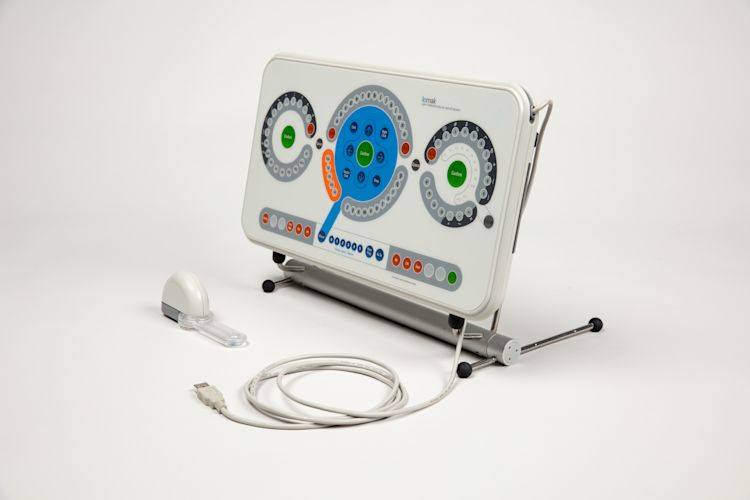
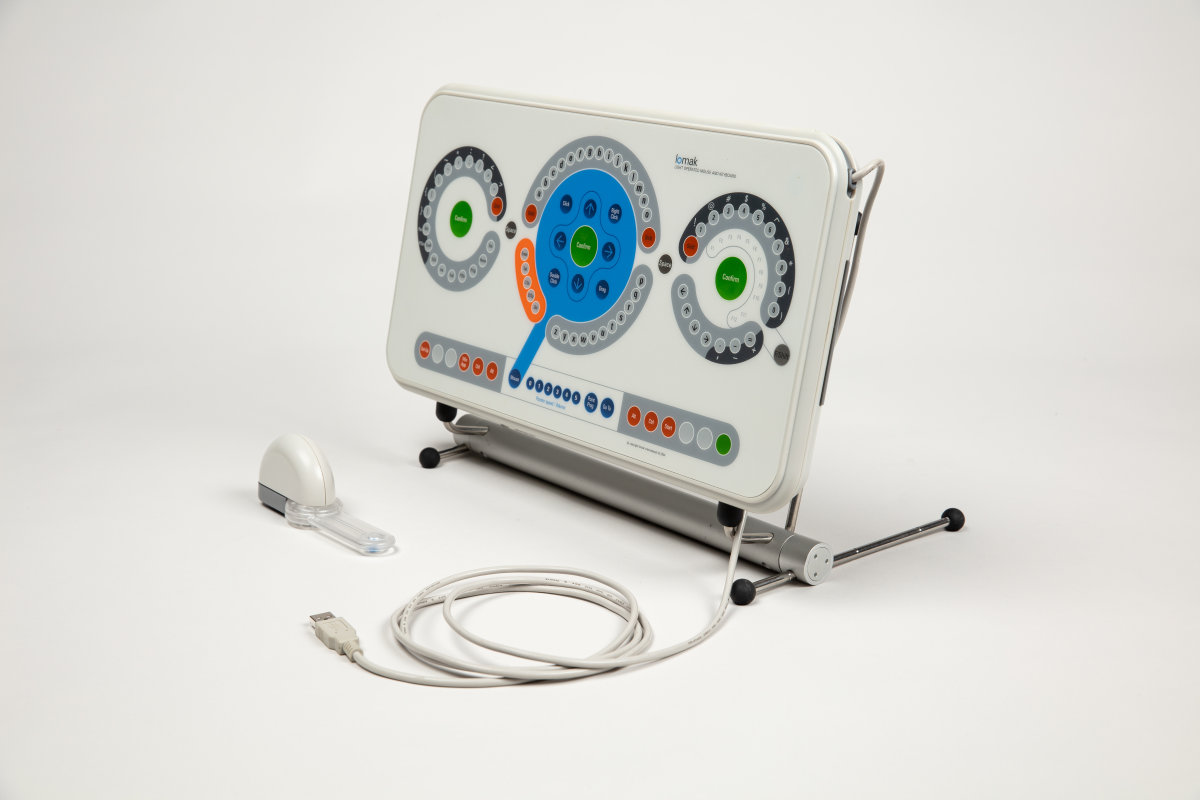
20 years in development
The LOMAK (Light Operated Mouse and Keyboard) is an assistive technology device developed by Aucklander Mike Watling for those who cannot use a standard computer keyboard or mouse. After experiencing first-hand how difficult communicating could be for severely disabled people and the limited tools available to assist
them, Watling designed, tested and prototyped this keyboard and mouse. His intention was to not only improve his primary target group’s ease of communication but also improve their access to education and their entry into and success within the workforce. During the 20-year development of the LOMAK, Watling harnessed technologies as they became available, such as lasers for pointing. The LOMAK also demonstrates the social benefits of technology, by allowing those previously isolated to connect more widely through the internet, a connection outside an individual’s immediate situation that is now taken for granted by most of us.
In 1982, Watling, an experienced electrician, visited a residential home for disabled youth to upgrade an electric wheelchair for one of the residents. He found communicating with some of the residents there, most with cerebral palsy Hōkai Nukurangi, difficult and frustrating. Speech impairments can be common among people with cerebral palsy [1], as the condition can affect the development of the musculature needed to control speech. The communication tools available to those in the home were limited, one resident for example was using a cardboard picture board and blinking her eyes to convey information. Without any experience of or training in this communication method, Watling couldn’t understand even her simplest message. Leaving the home, Watling believed he could make a machine that would speak – a communication unit. He described seeing a need that he thought could be tackled with electronics and computers, technology that surrounded him in his workplace but was not evident in the residential home.
Work to use and adapt available technologies to assist in communication for the disabled began in Europe in the 1960s. The POSM, Patient Operated Selector Mechanism, a typewriter with a “sip-and-puff” mouth controller, prototyped in 1960 by Reg Maling is believed to be the first electric communication device designed for disabled people [2]. Other devices, also based on typewriters, were developed during the 1960s, including the Patient Initiated Lightspot Operated Typewriter (PILOT), which used a light beam pointed at photoelectric cells. More portable systems, using transistors, began to appear in the 1970s, removing the need for the user to be bound to a stationary device. Speech synthesis was another area of research in the 1970s, and in the early 1980s, as computers became more widely available, work began on developing alternative input devices, beyond the standard keyboard. This field of research and development, and the devices produced, is now known as Augmentative and Alternative Communication (AAC).
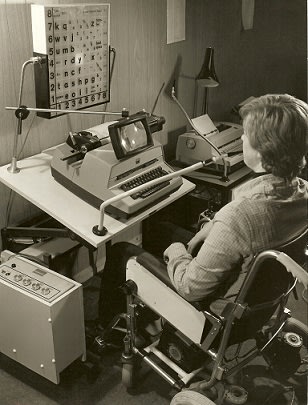
Early 1960s image of a user operating an electric communication device in the form of a sip-and-puff typewriter controller named the Patient Operated Selector Mechanism (POSM or POSSUM), which was developed in the United Kingdom. Released into the public domain by Possum company.
Using a light beam
While research was happening internationally and technological developments in general were also helping advances in this area, the type of inexpensive communication board Watling encountered remained widely used. The earliest communication boards are believed to have been in use in the 1920s and included both letters and frequently used words. Other versions include pictures, and combinations of letters, pictures, symbols, and words, in different quantities. Different methods of indicating were used with the boards, for example using finger movements or pointers.
Watling’s initial concept was for a beam of light moved over a light sensitive grid to draw a letter that a connected computer would recognise. The use of light was intended to eliminate the friction and associated fatigue that comes with repeatedly moving a physical pointer on a solid surface, for example a head stick or mouth stick on a standard keyboard. He also believed this concept would increase the user’s speed over using a physical pointer, or actuator as Watling refers to it. Small lasers weren’t available in the early 1980s, so Watling started working with security photo-sensors and infra-red beams, attempting to draw a letter with the infra-red beam on a target of photo-sensors. Watling was working on this around his day job and grappling with two major problems – how to produce words in symbolic form and how to eliminate incorrect selections. His theory moved on from drawing letters to selecting letters from a circular arrangement of the alphabet, and into the centre of this circle he introduced a confirm key, which, when triggered, sends the last character or function key chosen to the computer. Watling still sees this last breakthrough as key to the LOMAK concept and although the final product is a giant leap from his first prototype, the circular arrangement of letters and central confirmation point underpin the design.
Controlled from glasses
The first prototype, named LOCT (Light Operated Computer Terminal) and built between 1982 and 1984, features a series of integrated circuits and phototransistors on the keyboard unit, which are activated by a beam of light from glasses worn by the user and plugged into the front of the keyboard. An LED and an infrared light (of the kind used in security doors) were positioned in the centre of the glasses, effectively sitting on the bridge of the user’s nose. The two beams converged through a lens on a loop that extends out from the glasses. With small head movements, the user could move the beam of light across the letter, number and command "keys" arranged on the keyboard in three circles. The letters were arranged alphabetically as Watling found this made sense to most users, rather than the QWERTY layout of a typical computer keyboard. Watling sought assistance with developing the keyboard from Russell McMahon, an electronics engineer, who also had an interest in assistive devices for the disabled and helped develop the interface between the keyboard and the receiving device. At this early stage, Watling was working with a television monitor rather than a computer. ASCII coding, an American-developed standard that assigns each character a number written in binary, was used to represent the letters, numbers, and other characters on the keyboard.
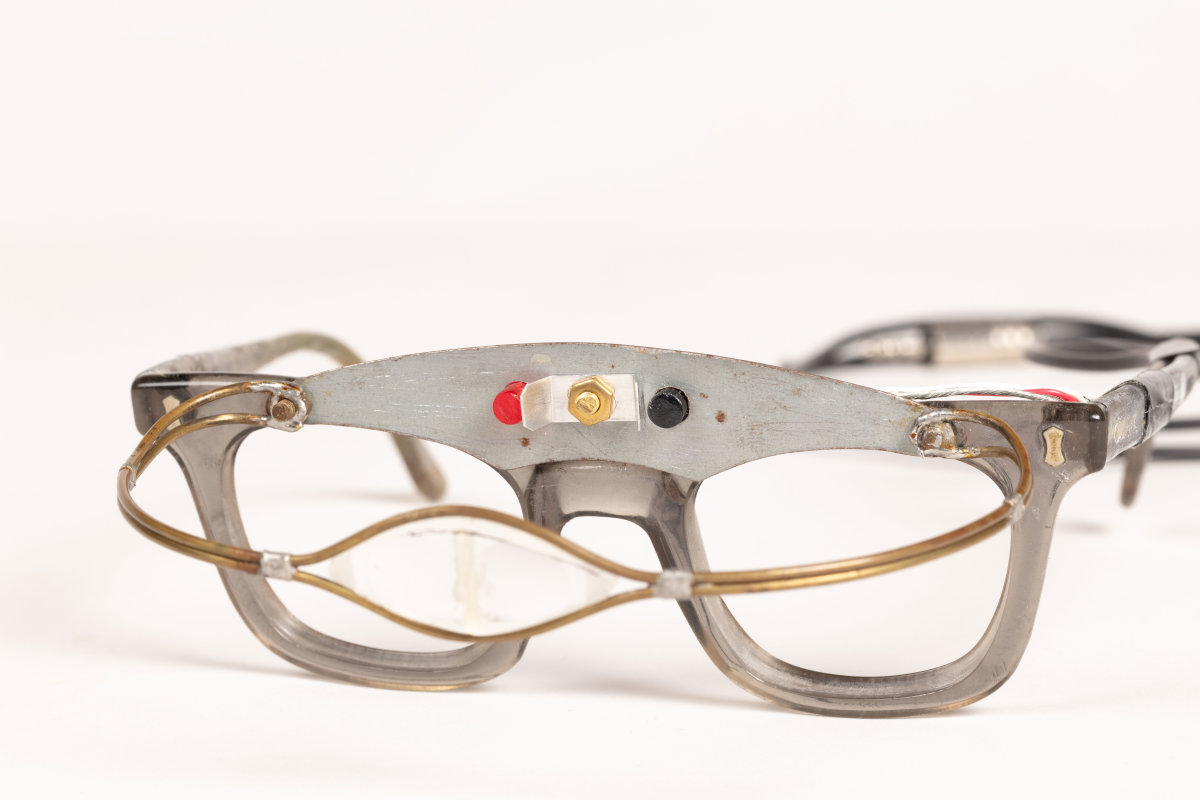
Prototype glasses [2021.48.2] The Museum of Transport and Technology (MOTAT)
Enthusiasm renewed
The LOCT was tested at the Otara Spinal Unit in 1984 by a resident with a physical impairment who had good head control. The testing highlighted work needed; greater control over the light source so as not to flood the sensors, and the impact of external interference, such as from infra-red heaters. The Otara testing was promising and although an approach to the DSIR (the former Department of Scientific and Industrial Research) for funding and assistance with computer technology was discouraging, Watling felt encouraged to approach companies with a view to developing a commercial product. There was no interest, however, in developing the LOCT and Watling stopped working on it, moving on to other projects.
Years later in 1998, Watling’s nephew, a professor at AUT, thought there may be interest there in the keyboard. Watling enrolled in a Diploma of Applied Sciences, commencing in 1999, which allowed him to work on the development of the keyboard and gave him access to the support and knowledge needed to bring it to a market-ready product.
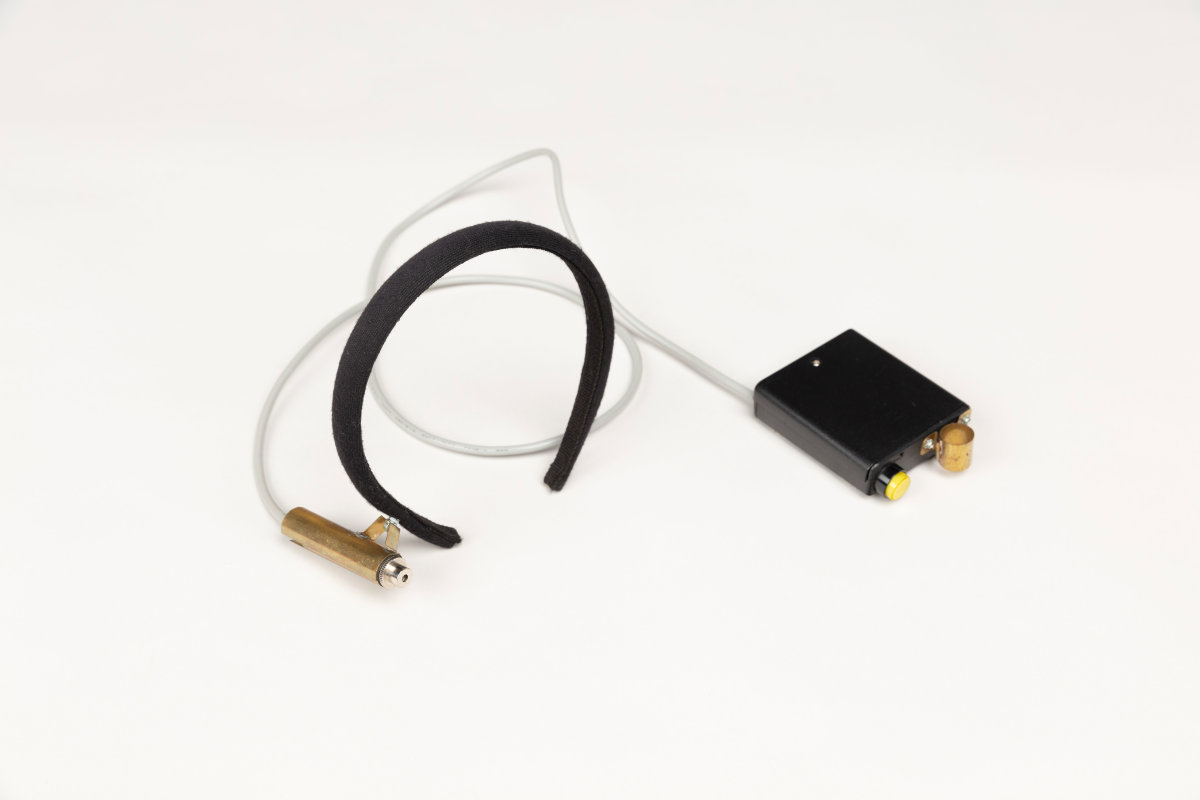
Laser headset prototype. [2021.48.18] The Museum of Transport and Technology (MOTAT)
Lasers are introduced
In 1998 Watling also started working with lasers as a light source, as they were now both more available and affordable. He trialled laser pointers purchased from Dick Smith Electronics and, after having problems modulating the laser, trialled an ultra-bright LED from the same retailer. The first laser headset, made in 1998, was powered by a battery pack attached by a wire, allowing the battery to sit on the user’s lap or in a shirt pocket for example. The laser was attached to the side of a headband. Moving the light source from the centre of the user’s head (where Watling had initially situated it as a central, pivotal point) to the side of the head, was based on feedback from users that suggested the side of the head was more aesthetically pleasing and less intrusive. For individuals who use assistive devices it can be important that those devices do not make them “feel less normal … or more disabled than they are.” [3] Wearing a headset in an office setting, such as in a role involving a lot of speaking on the telephone, would be quite normal, so a headband was felt to be less obvious. For users with hand control, the laser was able to be removed from the holder on the headband and put into a holder on the battery pack. Watling also trialled lasers in caps and rechargeable batteries from electric toothbrushes in place of standard batteries.
The Internet and AUT provide new resources
Along with access to an academic library at AUT, the advent of the Internet supported Watling’s research, and his research diary entries for that year record research into camera eye scanner units, alternative keyboards for those with typing injuries, and assistive technology devices on the international market, including The HeadMaster, a head-pointing system that replaces a hand-operated mouse.
Significant development in the electronics of the keyboard was also made possible through collaboration at AUT. Initially Watling had been working with electronic components attached to a bread board, whereas at AUT he was able to work with student Paul Balmer to draw circuits, using Balmer’s expertise in CAD, and, with wider collaboration in the Electronics department, create printed circuit boards. Used in the final product, printed circuit boards take up significantly less space, and are less fragile and more energy efficient than a board with circuit components attached to it. Widely used in consumer electronics since the mid-1950s, they were not, however, easily available to the innovator working alone in Aotearoa in the 1980s.
![Printed circuit board for LOMAK [2021.48.51] The Museum of Transport and Technology (MOTAT)](https://images.ctfassets.net/mplktqcfflsk/4ufLPoXgf6Q5pRU7oDUrWT/a0f1f07644e49ee7239185f9f18180cc/Image-6---2021.48.51_p1-web.jpg?w=1200&h=800&fl=progressive&q=85&fm=jpg&bg=transparent)
Printed circuit board for LOMAK [2021.48.51] The Museum of Transport and Technology (MOTAT)
Five identical prototypes were made at AUT in 2002 to test the concept with the disabled community, by which time the LOMAK name had been introduced. The curve in the 1983 LOCT prototype disappeared, the software had been further developed from the initial programming for the LOCT, with involvement from programmer David Taylor, and lasers were settled on as the light source. The lasers used with the 2002 prototypes were modulated; with the laser and the receiver set to the same frequency more control was possible over the signal. The 2002 prototype also includes a mouse function to allow the user to access and work on the Internet. Initially Watling had seen the keyboard purely as a writing tool but in the two decades since the initial concept the Internet had become an important tool for communication and connection and so the ability to click and select became essential. Karen Elliott, a postgraduate research student at AUT with tetraplegia, worked with Watling on the project from the beginning of his time at AUT, looking particularly at usability. Elliott wrote a typing tutorial and test used to test the 2002 prototypes, building on the earlier tutorial and test she had written for the LOCT prototype.
![Prototype keyboard [LOMAK] [2021.48.4] The Museum of Transport and Technology (MOTAT)](https://images.ctfassets.net/mplktqcfflsk/jXk9aAWRh3T2dozoTNdJh/ba0060a4be859ba4be226645316e3353/Image-7---2021.48.4_p2-web.jpg?w=1200&h=800&fl=progressive&q=85&fm=jpg&bg=transparent)
Prototype keyboard [LOMAK] [2021.48.4] The Museum of Transport and Technology (MOTAT)
Commercialisation
In 2002, through AUT, Chris Mulcare of Realize Technology became involved in the project, looking to develop the LOMAK further as a commercial product. Realize had been established two years earlier to support commercialising science research from New Zealand’s universities and Crown Research Institutes. The LOMAK was now put through further testing, including technical analysis, market research and clinical assessment by Talk Link, an assistive technology assessment agency for the Ministry of Health. Mulcare brought Peter Haythornthwaite of Creativelab into the project. Haythornthwaite, an industrial designer, designed a different faceplate for one of the five prototypes, introducing more colour to make it more aesthetically pleasing and to see whether there was an effect on usability. This change was design-driven, and the electronics in this prototype are the same as in the other four prototypes.
As the design work continued, Mulcare and Haythornthwaite’s team also introduced a hand unit. Although Watling had introduced hand control as an option with an early laser headset, where the laser pointer could be removed from the head-mounted holder and attached to the battery pack to work as a hand unit, and he had experimented with other versions of hand units, his overriding interest was in providing head control for severely disabled users.
![LOMAK hand unit [2021.48.50] The Museum of Transport and Technology (MOTAT)](https://images.ctfassets.net/mplktqcfflsk/7eahRNuDg9EwbTKIGpp7PY/0763143e2c150bdbed4b7f7fc977ad1e/Image-9--2021.48.50_p8-web.jpg?w=1200&h=800&fl=progressive&q=85&fm=jpg&bg=transparent)
LOMAK hand unit [2021.48.50] The Museum of Transport and Technology (MOTAT)
User testing
Once Haythornthwaite and Mulcare were on board as designers Watling was no longer as involved in design considerations such as this, however, continued working two days a week on the LOMAK on the technical development, collaborating in particular with Roger Clist who was working on the programming. Additional expertise was provided by Callahan Innovation. Testing the prototypes within the disabled community and receiving feedback from potential end users remained a key part of the process for Watling; his diary entries from April 2005 document working with users around head mounting systems for the laser unit and trialling caps, glasses frames and headbands.
![LOMAK headband and laser unit [2021.48.19] The Museum of Transport and Technology (MOTAT)](https://images.ctfassets.net/mplktqcfflsk/1yegrBSBH8DvA7aMkV321W/c2cc80fd6fd8bd3cfac07a89d5e519cb/Image-10---2021.48.19_p3-web.jpg?w=1200&h=800&fl=progressive&q=85&fm=jpg&bg=transparent)
LOMAK headband and laser unit [2021.48.19] The Museum of Transport and Technology (MOTAT)
International recognition
Watling’s aim was to make a product that could be priced under $600 so that it would be an affordable purchase for individuals. The complete final product, with two laser units, retailed for around $2,500 when it was launched in 2005. A keyboard and one laser unit, for either head or hand use, was around $2,000. Although not the price Watling was hoping to achieve, the LOMAK was at the lower end of the price range in the market at the time. The HeadMaster for example retailed at around $6,000. A key feature of the LOMAK was that it could be used with any computer with a USB port and no additional software was needed, as it effectively replaced the standard keyboard to operate the software already installed on the user’s computer.
![Keyboard “K1,” the first LOMAK with a serial number, used in New Plymouth. [2021.48.7] The Museum of Transport and Technology (MOTAT)](https://images.ctfassets.net/mplktqcfflsk/39vwBpatsyeFfX8FDBw3SP/df460ff1470629bd990ddd5b8e802257/Image-11---2021.48.7_p1-web.jpg?w=1200&h=800&fl=progressive&q=85&fm=jpg&bg=transparent)
Keyboard “K1,” the first LOMAK with a serial number, used in New Plymouth. [2021.48.7] The Museum of Transport and Technology (MOTAT)
About 500 LOMAKs were sold worldwide before Opdo Ltd, the company formed to market and distribute it, folded in 2009 following an unsuccessful attempt to expand into the American market alongside the 2007-2008 Global Financial Crisis. The LOMAK has received recognition internationally; in 2007, it was awarded a gold medal at the International Design Excellence Awards (IDEA), organized annually by the Industrial Designers Society of America (IDSA) to recognize exceptional achievement in industrial design. An example has also been included in the Museum of Modern Art collection in New York, no mean feat for a product developed from a germ of an idea by a Kiwi electrician with a desire to help. And although the LOMAK didn’t work for the individual who originally inspired Watling, it was a success for numerous others, including then high-school aged brothers Ryan and Blake Leitch who were closely involved in trialling the keyboard during its development process. Watling has continued to work in the Augmentative and Alternative Communication space with his current project, the J-Key, which can also replace a standard keyboard and mouse, trialled with students at Central Auckland Specialist School in 2020.
Story by Nicola Jennings, Senior Curator – Technology (MOTAT)
Story edited by Belinda Nevin, Head of Curatorial Research (MOTAT) and Mike Watling.
Published November 2023
End notes:
[1] Of the 1,416 individuals with cerebral palsy on The New Zealand Cerebral Palsy Register in 2022, 47% had an associated speech condition. New Zealand Cerebral Palsy Register team (2022) Te Rēhita a Hōkai Nukurangi Aotearoa Rīpoata 2022 The New Zealand Cerebral Palsy Register Report 2022
[2] Vanderheiden, G.C. (2002) A Journey through early augmentative communication and computer access. Journal of Rehabilitation Research and Development. Vol. 9 (No. 6, supplement), 39-53
[3] Ravenberg, B and Söderström, S. (2017), p59. Disability, Society and Assistive Technology. Routledge.
Sources:
Beston, A (17 May 2005), Keyboard opens brave new world. New Zealand Herald. https://www.nzherald.co.nz/nz/keyboard-opens-brave-new-world/2OOWYQSKADC2PTKZZ7CDUNTEAM/
Cerebral Palsy Society of NZ (2021) Effects of Cerebral Palsy. https://cerebralpalsy.org.nz/cerebral-palsy/effects-of-cerebral-palsy/
Cerebral Palsy Society of NZ (6 May 2022) Te Reo word for Cerebral Palsy developed. https://cerebralpalsy.org.nz/te-reo-word-for-cerebral-palsy-developed/
New Zealand Cerebral Palsy Register team (2022) Te Rēhita a Hōkai Nukurangi Aotearoa Rīpoata 2022 The New Zealand Cerebral Palsy Register Report 2022 https://nz.cpregister.com/Public/nzl/20220908_NZCPR_Report.pdf
Ravenberg, B and Söderström, S. (2017) Disability, Society and Assistive Technology. Routledge.
Smythe, M. (2011) New Zealand by Design: A History of New Zealand Product Design. Godwit.
Smythe, M. (2014) Lomak mouse and keyboard Te Ara - the Encyclopedia of New Zealand. http://www.TeAra.govt.nz/en/photograph/41860/lomak-mouse-and-keyboard
Vanderheiden, G.C. (2002) A Journey through early augmentative communication and computer access. Journal of Rehabilitation Research and Development. Vol. 9 (No. 6, supplement) 39-53
Watling, M. et al. (1983-2015) Michael Watling Collection - LOMAK development COL-2021-1. Held at Walsh Memorial Library, The Museum of Transport and Technology (MOTAT).
Watling, M, in conversation with MOTAT Collections Hub staff, February and March 2020
Further reading:
https://www.motat.nz/collections-and-stories/stories/a-better-future-at-the-push-of-a-button/
Objects in the MOTAT Collection:
https://collection.motat.nz/objects/127875/light-operated-mouse-and-keyboard-lomak
https://collection.motat.nz/objects/129427/prototype-keyboard-loct
https://collection.motat.nz/objects/129466/prototype-glasses-lomak
https://collection.motat.nz/objects/129451/laser-headset-prototype-lomak
https://collection.motat.nz/objects/129470/cap-with-laser-lomak
https://collection.motat.nz/objects/129473/prototype-laser-unit-lomak
https://collection.motat.nz/objects/129438/printed-circuit-board-lomak
https://collection.motat.nz/objects/129434/prototype-keyboard-lomak
https://collection.motat.nz/objects/129435/prototype-keyboard-lomak
https://collection.motat.nz/objects/129420/hand-mouse-lomak
https://collection.motat.nz/objects/129444/headband-lomak
https://collection.motat.nz/objects/129474/keyboard-k1-lomak
![Prototype keyboard, LOCT (Light Operated Computer Terminal) [2021.48.3] The Museum of Transport and Technology (MOTAT)](https://images.ctfassets.net/mplktqcfflsk/3OOdFxWhBlkszpf9Yox7Oo/974f1105ff9bc82dab0424b9b3e1cae7/Image-1a---2021.48.3_p5-web.jpg?w=750&h=500&fl=progressive&q=80&fm=jpg&bg=transparent)
![Prototype keyboard, LOCT (Light Operated Computer Terminal), reverse. [2021.48.3] The Museum of Transport and Technology (MOTAT)](https://images.ctfassets.net/mplktqcfflsk/5OKEt0xUPgLs78HcYFVnrT/15b2fd4e7e4573cc86b096c2285367f2/Image-1b---2021.48.3_p6-web.jpg?w=750&h=500&fl=progressive&q=80&fm=jpg&bg=transparent)
![Cap with laser [2021.48.16] The Museum of Transport and Technology (MOTAT)](https://images.ctfassets.net/mplktqcfflsk/72sJI6gPsuMWoAUMjeB1Px/53e18260132173763c4587c486eb981b/Image-4a---2021.48.16_p4-web.jpg?w=750&h=1125&fl=progressive&q=80&fm=jpg&bg=transparent)
![Cap with laser [2021.48.16] The Museum of Transport and Technology (MOTAT)](https://images.ctfassets.net/mplktqcfflsk/1RsoWewwhBR7w9XGIHMqBU/efdabd2c985809a862ef0ba2eb4291c2/Image-4b---2021.48.16_p1-web.jpg?w=750&h=500&fl=progressive&q=80&fm=jpg&bg=transparent)
![Cap with laser [2021.48.16] The Museum of Transport and Technology (MOTAT)](https://images.ctfassets.net/mplktqcfflsk/7I9W0MC3mlqXicAmtxZTou/e3cef238ea5b7e34242bb36c3971b625/Image-4c---2021.48.16_p5-web.jpg?w=750&h=1125&fl=progressive&q=80&fm=jpg&bg=transparent)
![Rechargeable laser unit prototype. [2021.48.15] The Museum of Transport and Technology (MOTAT)](https://images.ctfassets.net/mplktqcfflsk/zrKVqVmV0MKgngnWSRg1D/bacb4efd9cb4dc697f26ecb8dc7cce62/Image-5a---2021.48.15_p2-web.jpg?w=750&h=500&fl=progressive&q=80&fm=jpg&bg=transparent)
![Rechargeable laser unit prototype. [2021.48.15] The Museum of Transport and Technology (MOTAT)](https://images.ctfassets.net/mplktqcfflsk/4EyYIK0UqtSyY9wwOWp9CA/a8c7144dbc6f67107344c355438a3ebc/Image-5b---2021.48.15_p4-web.jpg?w=750&h=500&fl=progressive&q=80&fm=jpg&bg=transparent)
![Rechargeable laser unit prototype. [2021.48.15] The Museum of Transport and Technology (MOTAT)](https://images.ctfassets.net/mplktqcfflsk/3crOhlcnrzFvAvTC5UUve3/99cb3462a2bd6718640af0e7a260c882/Image-5c---2021.48.15_p8-web.jpg?w=750&h=500&fl=progressive&q=80&fm=jpg&bg=transparent)
![Rechargeable laser unit prototype. [2021.48.15] The Museum of Transport and Technology (MOTAT)](https://images.ctfassets.net/mplktqcfflsk/1elI8viZb4gJjfZ4ZkAzY9/3649e71b62dc8bed0a7606167fd966dd/Image-5d--2021.48.15_p12-web.jpg?w=750&h=500&fl=progressive&q=80&fm=jpg&bg=transparent)
![Rechargeable laser unit prototype. [2021.48.15] The Museum of Transport and Technology (MOTAT)](https://images.ctfassets.net/mplktqcfflsk/5I4h2kJqpA0p3WX1JhY45Q/7cbe1de77cb1471bfd9a2c6dcb25f5e4/Image-5e---2021.48.15_p13-web.jpg?w=750&h=1125&fl=progressive&q=80&fm=jpg&bg=transparent)
![Prototype keyboard [LOMAK] [2021.48.5] The Museum of Transport and Technology (MOTAT)](https://images.ctfassets.net/mplktqcfflsk/6sAOjsvnoQBMkVh3WPjIap/dfb22de91448c889ce34a9fd15f8da22/Image-8a--2021.48.5_p1-web.jpg?w=750&h=500&fl=progressive&q=80&fm=jpg&bg=transparent)
![Prototype keyboard [LOMAK] [2021.48.5] The Museum of Transport and Technology (MOTAT)](https://images.ctfassets.net/mplktqcfflsk/65Y9ieinbmQ9VfAgZBpNNb/34266fc3967f5978a95ff43678d0289f/Image-8b---2021.48.5_p7-web.jpg?w=750&h=500&fl=progressive&q=80&fm=jpg&bg=transparent)